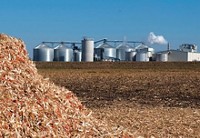Advertisement
Grab your lab coat. Let's get started
Welcome!
Welcome!
Create an account below to get 6 C&EN articles per month, receive newsletters and more - all free.
It seems this is your first time logging in online. Please enter the following information to continue.
As an ACS member you automatically get access to this site. All we need is few more details to create your reading experience.
Not you? Sign in with a different account.
Not you? Sign in with a different account.
ERROR 1
ERROR 1
ERROR 2
ERROR 2
ERROR 2
ERROR 2
ERROR 2
Password and Confirm password must match.
If you have an ACS member number, please enter it here so we can link this account to your membership. (optional)
ERROR 2
ACS values your privacy. By submitting your information, you are gaining access to C&EN and subscribing to our weekly newsletter. We use the information you provide to make your reading experience better, and we will never sell your data to third party members.
Business
A New Job For Enzymes
Commercializing cellulosic ethanol will require enzymes and perhaps government help as well
by Michael McCoy
February 20, 2006
| A version of this story appeared in
Volume 84, Issue 8

Can two Danish enzyme companies be part of the cure for the U.S.'s addiction to oil?
In his State of the Union address on Jan. 31, President George W. Bush proposed the Advanced Energy Initiative, a 22% increase in Department of Energy funding for clean energy research. The President's fiscal 2007 budget will seek $150 million for research into new methods of making ethanol, "not just from corn," he said, "but from wood chips, stalks, or switchgrass." His goal is to make this biomass-based ethanol "practical and competitive" within six years.
Most Americans listening to the speech wouldn't know that making biomass ethanol requires enzymes???and lots of them. Many investors do, however, and the following day, the stock price of the Danish enzyme company Novozymes rose almost 6%, its largest one-day gain in more than a year. Shares in Danisco, the Danish food ingredients firm that owns Genencor International, Novozymes' main rival, climbed a more modest 1.6%.
Investors who bought shares in Novozymes and Danisco are betting that the two companies will benefit handsomely from a major government push for biomass ethanol, much as they have already from the big ramp-up in production of traditional corn-based ethanol over the past several years.
Per Falholt, chief science officer at Novozymes, explains that ethanol can be made from a number of carbohydrate sources. In Brazil, the source is sugarcane-derived sucrose, which is directly fermented with yeast into ethanol.
In the U.S., ethanol producers typically start with cornstarch, use amylase and amyloglucosidase enzymes to break it down into glucose, and then ferment the six-carbon sugar into ethanol. In Europe, wheat, barley, and rye are the chief starch sources.
This traditional ethanol business has been good to enzyme producers. U.S. ethanol output rose close to 15% in 2005, and Novozymes' enzyme sales to the ethanol industry grew significantly faster than that, according to Peder Holk Nielsen, Novozymes' executive vice president of sales and marketing. He attributes the above-market gains to a new generation of enzymes that help ethanol producers save money and obtain more value from fermentation by-products.
Biomass ethanol is made from the stalks left over from corn harvesting or from other cellulosic agricultural materials with little commercial value. These include waste wood and switchgrass—a fast-growing grass that once covered the Great Plains—as the President mentioned in his speech.
Unlike cornstarch, though, these materials are mostly cellulose. Breaking them down requires pretreatment with dilute acid or other techniques, followed by degradation with cellulase enzymes to obtain glucose and other five- and six-carbon sugars.
Starting in 2000, Genencor and Novozymes each conducted four-year R&D projects with the Department of Energy's National Renewable Energy Laboratory aimed at reducing the cost of making cellulase. The companies later announced huge reductions in the cost of making the enzyme, from more than $5.00 per gal of ethanol at the start of their projects to less than 20 cents per gal at the end.
Both research projects have been wrapped up, and the companies are fine-tuning the enzymes on their own. Further cellulase cost improvements are possible, but enzyme company executives say the bigger hurdles now are creating the infrastructure to collect biomass and developing the "biorefineries" that integrate collection, treatment, and fermentation into an efficient production process. A particular sticking point is fermenting the five-carbon sugars that make up a good portion of cellulosic biomass.
Jack Huttner, the Genencor executive responsible for biorefinery business development, argues that evolution of biomass ethanol has reached a point where the government needs to step in. "Right now, because of the integration challenge and the economics of being a pioneer, this integration process is kind of stalled," he says.
Huttner would like to see the Energy Department sponsor the ethanol equivalent of a Defense Department jet fighter "fly-off." Competing teams of scientists, farmers, and the like would come together to build working biorefineries at, say, one-tenth of their expected commercial size.
Without this kind of group effort, biomass ethanol will remain expensive. Novozymes' Falholt estimates that making it commercially would cost about 50% more than corn-based ethanol does today. Real-life production experience at a government-backed biorefinery, though, should bring costs down. Meanwhile, conventional ethanol stands to get more expensive as fermenters buy up more and more of the corn crop.
 Today, U.S. ethanol companies, led by the agribusiness giant Archer Daniels Midland, produce close to 4 billion gal of the cornstarch-based fuel per year, according to the Renewable Fuels Association, supplying about 3% of the country's automobile fuel needs and consuming about 12% of the domestic corn crop in the process.
Today, U.S. ethanol companies, led by the agribusiness giant Archer Daniels Midland, produce close to 4 billion gal of the cornstarch-based fuel per year, according to the Renewable Fuels Association, supplying about 3% of the country's automobile fuel needs and consuming about 12% of the domestic corn crop in the process.
Congress set a goal last year of doubling U.S. production of ethanol by 2012. At that point, about a quarter of the corn crop would be consumed, supplies for food and feed markets would be constrained, and corn prices would likely start to rise. "That's the window where biomass ethanol becomes interesting," Holk Nielsen says.
A backgrounder distributed with the State of the Union address says cellulosic ethanol has the potential to displace up to 30% of the nation's current fuel use. By Huttner's back-of-the-envelope calculation, that translates into 45 billion gal of ethanol per year, with not much more than 10 billion of it realistically coming from cornstarch.
For now, large-scale biomass ethanol production is just a dream, one that has led to its share of disappointments over the years. A 1998 C&EN article chronicled several biomass ethanol projects; none was built.
Iogen, a small Canadian enzyme company, operates the world's only biomass ethanol plant, a demonstration facility that it opened two years ago in Ottawa with financial backing from Shell and Petro-Canada. Iogen, Shell, and Volkswagen announced last month that they would study building a biomass ethanol plant in Germany.
Enzyme producers and others in the U.S. farm and biotech communities are now calling for Congress to fully fund both the President's energy initiative and the biorefinery loan and grant programs established in last year's Energy Policy Act. Huttner is hopeful. "With the President's attention, the news is that the Department of Energy and the appropriations cycle will be a lot more focused on this problem," he says.






Join the conversation
Contact the reporter
Submit a Letter to the Editor for publication
Engage with us on Twitter